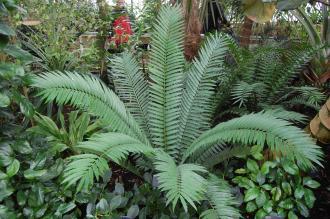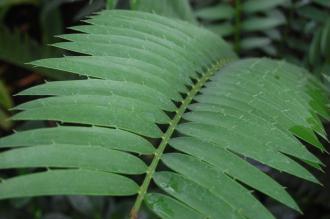
Encephalartos natalensis (28/02/2016, Kew Gardens, London)
Position: Full sun
Flowering period: Late spring to early summer
Soil: Moist, well drained
Eventual Height: 6m
Eventual Spread: 5m
Hardiness: 9b, 10a, 10b, 11
Family: Zamiaceae
Encephalartos natalensis is an evergreen, palm like shrub. Its dark green leaves are arching, up to 3m long and 40cm across. Its leaflets are lanceolate with occasional spines to their margins, up to 23cm long and 4.5cm across. Its may form a trunk which may achieve a diameter of up to 40cm. Its flowers are dioecious. Its yellow/ green male strobili (cone like structures) are cylindrical, up to 50m long and 12cm across. Its brown female ‘cones’ are egg shaped, up to 60cm long and 30cm across.
Encephalartos natalensis, commonly known as Natal Cycad or Natal Giant Cycad, is native to east South Africa. In its native habitat it grow on cliffs, rocky outcrops and forests. This plant is classified as Near Threatened according to the IUCN Red List of Threatened Species.
The etymological root of the binomial name Encephalartos is derived from the Greek en meaning ‘in’, kefalos meaning ‘head’ (brain) and artos meaning ‘cake’. Natalensis is named after KwaZulu-Natal, a region is South Africa from where this plant originates.
The landscape architect may find Encephalartos natalensis useful as an attractive palm like shrub suitable for atrium planting schemes. Once established this shrub is drought tolerant. Care should be taken when locating this plant has spiny leaves.

Encephalartos natalensis Leaf (28/02/2016, Kew Gardens, London)
Ecologically, Encephalartos natalensis may be attractive to pollinating insects.
Encephalartos natalensis prefers moist, fertile, well-drained soils. It prefers an acid to neutral pH of soil.
When maintaining Encephalartos natalensis in an internal environment its soil should be watered regularly, but never wet. Watering should be reduced during the winter months. Its preferred active growing temperature rages from between 16ºc to 24ºc, although it will tolerate temperatures as low as freezing during the winter months. Feeding with weak fertiliser solution should be carried out once a month during the growing season.

Landscape Architecture

